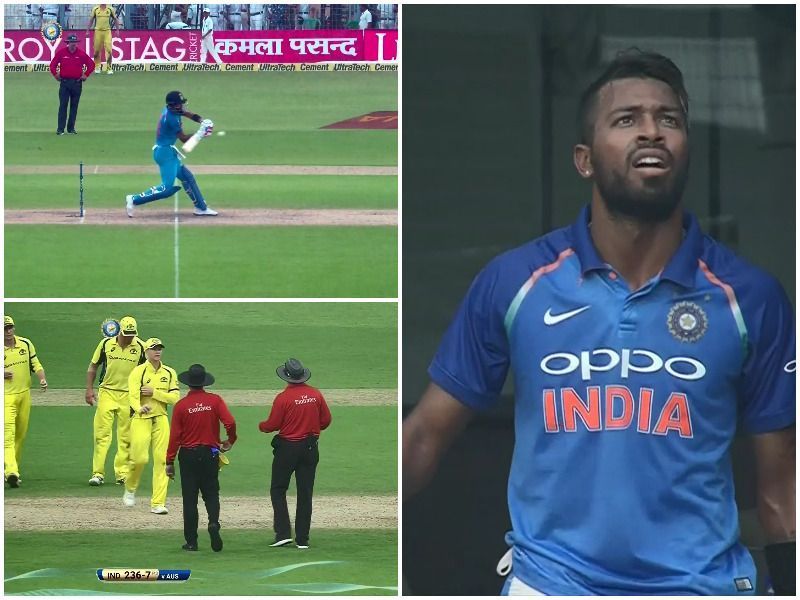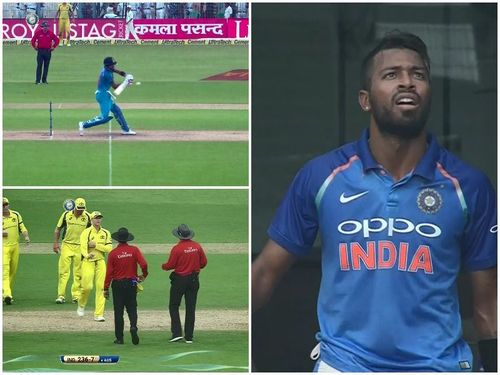
India vs Australia 2017, 2nd ODI: Hardik Pandya's lucky escape is SK Play of the Day

The ongoing 5-match ODI series against Australia is turning out to be an eventful affair for Hardik Pandya. Following a blistering knock in the first game in Chennai, the Indian all-rounder managed to survive a legitimate run-out appeal during the second match at the iconic Eden Gardens in Kolkata.
The fascinating incident happened in the 48th over of India's innings. Even as the heavens began to open up just before the fourth delivery, Kane Richardson unleashed a waist-high full toss against Pandya.
The hard-hitter's almighty heave sent the ball sailing into the twilight sky and Steven Smith circled underneath to complete a brilliant catch. Showing his remarkable game awareness, the Australian skipper immediately signaled Richardson to get closer to the stumps and unleashed a precise throw towards the non-striker's end. The fast bowler whipped the bails off to set off fervent appeals from the visitors.
Meanwhile, unaware of what was happening in the surroundings, Pandya, as well as his batting partner Bhuvneshwar Kumar, walked off as soon as the raindrops landed on the ground. At a similar juncture, the on-field umpires also began to leave the field as the ground staff rushed in to cover the playing area. Australia's appeals for a run-out/catch meant that there was complete chaos on the field.
As the camera panned to the encasement containing third umpire Marais Erasmus and match referee Jeff Crowe, there was a sudden scramble for the rule book. Even the commentators on air feverishly rummaged through the Internet to make sense of the proceedings.
When the rain finally subsided, the Australians, led by Smith, were seen engaging in dramatic discussions with the two umpires. Nitin Menon, reserve umpire for the game, joined in on the unfolding mayhem too.
Subsequent replays had confirmed that the ball was indeed above waist height and hence was deemed a no-ball. However, the Australian team were busy appealing for the run-out. Arguing that Pandya had left the field thinking that he was out caught or to protect himself from the onset of rain, the umpires affirmed that the ball had to be deemed dead from the particular moment onward.
According to Law 23.1 (Dead Ball) of MCC's playing rules,
(b) The ball shall be considered to be dead when it is clear to the bowler’s end umpire that the fielding side and both batsmen at the wicket have ceased to regard it as in play.
The umpires then invoked Law 27.7 (Appeals) of MCC's playing regulations which entail the case of 'batsman leaving his wicket under a misapprehension'.
An umpire shall intervene if satisfied that a batsman, not having been given out, has left his wicket under a misapprehension that he is out. The umpire intervening shall call and signal Dead ball to prevent any further action by the fielding side and shall recall the batsman.
Eventually, Pandya was reprieved and the delivery was adjudged a no-ball. This was a unique instance wherein the umpires had to call a no-ball and dead ball at different stages of the same delivery.
Since the batsmen had crossed over before the maelstrom ensued, Bhuvneshwar Kumar found himself facing the free-hit after play resumed. But Richardson kept his nerve to prevent any damage.
With the confusing incident playing on his mind, Smith went on to drop a catch, handing Bhuvneshwar a second life. Much to the Australian skipper's relief, the seamer holed out in the very next ball.
Richardson finally had his man when he nabbed Pandya after the latter tried to throw the kitchen sink at a slow full toss during the start of the final over of the innings. In the end, India were bowled out for 252 from their full quota of overs.